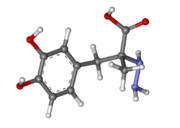Carbidopa
From Proteopedia
(Difference between revisions)
| Line 15: | Line 15: | ||
== Disease in Humans == | == Disease in Humans == | ||
| - | Parkinson's disease (PD) is a chronic, progressive neurological disease whose symptoms include bradykinesia, tremors, postural instability and rigidity. Although the exact cause of the disease is currently unknown, it is believe to be caused by the apoptosis of dopanergic cells in the substantia nigra of the brain and subsequent loss of dopamine.<ref name="seven">PMID:10746727</ref>Carbidopa is mostly related to people with Parkinson’s disease. According to the National Parkinson Foundation, Levodopa alone is known to cause nausea and vomiting in Parkinson’s patients, and Carbidopa prevents those side effects. Carbidopa can act as an enhancer for Levodopa by decreasing the dosage of Levodopa needed for Parkinson’s patients, about 80%. Current treatments for Parkinson’s disease are combined tablet of Carbidopa and Levodopa (Sinemet), which are offered as immediate-release tablets and slow-release tablets, along with dissolvable tablets. | + | Parkinson's disease (PD) is a chronic, progressive neurological disease whose symptoms include bradykinesia, tremors, postural instability and rigidity. Although the exact cause of the disease is currently unknown, it is believe to be caused by the apoptosis of dopanergic cells in the substantia nigra of the brain and subsequent loss of dopamine.<ref name="seven">PMID:10746727</ref>Carbidopa is mostly related to people with Parkinson’s disease. According to the National Parkinson Foundation, Levodopa alone is known to cause nausea and vomiting in Parkinson’s patients, and Carbidopa prevents those side effects.<ref name="eight">http://www.parkinson.org/understanding-parkinsons/treatment/Medications-for-Motor-Symptoms/Carbidopa-levodopa</ref> Carbidopa can act as an enhancer for Levodopa by decreasing the dosage of Levodopa needed for Parkinson’s patients, about 80%. Current treatments for Parkinson’s disease are combined tablet of Carbidopa and Levodopa (Sinemet), which are offered as immediate-release tablets and slow-release tablets, along with dissolvable tablets.<ref name="nine">http://www.merck.com/product/home.html</ref> |
| + | |||
| + | <ref name="eleven">PMID:18828673</ref> | ||
Revision as of 19:58, 16 November 2016
Carbidoba ((2S)-3-(3,4-dihydroxyphenyl)-2-hydrazinyl-2-methylpropanoic acid)
| |||||||||||
References
- ↑ Gilbert JA, Frederick LM, Ames MM. The aromatic-L-amino acid decarboxylase inhibitor carbidopa is selectively cytotoxic to human pulmonary carcinoid and small cell lung carcinoma cells. Clin Cancer Res. 2000 Nov;6(11):4365-72. PMID:11106255
- ↑ https://pubchem.ncbi.nlm.nih.gov/compound/carbidopa#section=Top
- ↑ Opacka-Juffry J, Brooks DJ. L-dihydroxyphenylalanine and its decarboxylase: new ideas on their neuroregulatory roles. Mov Disord. 1995 May;10(3):241-9. PMID:7651438 doi:http://dx.doi.org/10.1002/mds.870100302
- ↑ Schneider G, Kack H, Lindqvist Y. The manifold of vitamin B6 dependent enzymes. Structure. 2000 Jan 15;8(1):R1-6. PMID:10673430
- ↑ Burkhard P, Dominici P, Borri-Voltattorni C, Jansonius JN, Malashkevich VN. Structural insight into Parkinson's disease treatment from drug-inhibited DOPA decarboxylase. Nat Struct Biol. 2001 Nov;8(11):963-7. PMID:11685243 doi:http://dx.doi.org/10.1038/nsb1101-963
- ↑ Ishii S, Mizuguchi H, Nishino J, Hayashi H, Kagamiyama H. Functionally important residues of aromatic L-amino acid decarboxylase probed by sequence alignment and site-directed mutagenesis. J Biochem. 1996 Aug;120(2):369-76. PMID:8889823
- ↑ Feany MB, Bender WW. A Drosophila model of Parkinson's disease. Nature. 2000 Mar 23;404(6776):394-8. PMID:10746727 doi:http://dx.doi.org/10.1038/35006074
- ↑ http://www.parkinson.org/understanding-parkinsons/treatment/Medications-for-Motor-Symptoms/Carbidopa-levodopa
- ↑ http://www.merck.com/product/home.html
- ↑ Lopez VM, Decatur CL, Stamer WD, Lynch RM, McKay BS. L-DOPA is an endogenous ligand for OA1. PLoS Biol. 2008 Sep 30;6(9):e236. doi: 10.1371/journal.pbio.0060236. PMID:18828673 doi:http://dx.doi.org/10.1371/journal.pbio.0060236




